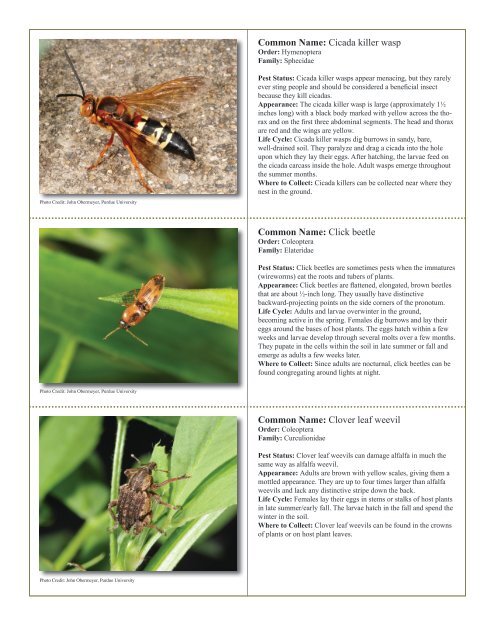to download pdf - Purdue Extension Entomology - Purdue University
to download pdf - Purdue Extension Entomology - Purdue University
to download pdf - Purdue Extension Entomology - Purdue University
You also want an ePaper? Increase the reach of your titles
YUMPU automatically turns print PDFs into web optimized ePapers that Google loves.
Common Name: Cicada killer wasp<br />
Order: Hymenoptera<br />
Family: Sphecidae<br />
Pho<strong>to</strong> Credit: John Obermeyer, <strong>Purdue</strong> <strong>University</strong><br />
Pest Status: Cicada killer wasps appear menacing, but they rarely<br />
ever sting people and should be considered a beneficial insect<br />
because they kill cicadas.<br />
Appearance: The cicada killer wasp is large (approximately 1½<br />
inches long) with a black body marked with yellow across the thorax<br />
and on the first three abdominal segments. The head and thorax<br />
are red and the wings are yellow.<br />
Life Cycle: Cicada killer wasps dig burrows in sandy, bare,<br />
well-drained soil. They paralyze and drag a cicada in<strong>to</strong> the hole<br />
upon which they lay their eggs. After hatching, the larvae feed on<br />
the cicada carcass inside the hole. Adult wasps emerge throughout<br />
the summer months.<br />
Where <strong>to</strong> Collect: Cicada killers can be collected near where they<br />
nest in the ground.<br />
Common Name: Click beetle<br />
Order: Coleoptera<br />
Family: Elateridae<br />
Pest Status: Click beetles are sometimes pests when the immatures<br />
(wireworms) eat the roots and tubers of plants.<br />
Appearance: Click beetles are flattened, elongated, brown beetles<br />
that are about ½-inch long. They usually have distinctive<br />
backward-projecting points on the side corners of the pronotum.<br />
Life Cycle: Adults and larvae overwinter in the ground,<br />
becoming active in the spring. Females dig burrows and lay their<br />
eggs around the bases of host plants. The eggs hatch within a few<br />
weeks and larvae develop through several molts over a few months.<br />
They pupate in the cells within the soil in late summer or fall and<br />
emerge as adults a few weeks later.<br />
Where <strong>to</strong> Collect: Since adults are nocturnal, click beetles can be<br />
found congregating around lights at night.<br />
Pho<strong>to</strong> Credit: John Obermeyer, <strong>Purdue</strong> <strong>University</strong><br />
Common Name: Clover leaf weevil<br />
Order: Coleoptera<br />
Family: Curculionidae<br />
Pest Status: Clover leaf weevils can damage alfalfa in much the<br />
same way as alfalfa weevil.<br />
Appearance: Adults are brown with yellow scales, giving them a<br />
mottled appearance. They are up <strong>to</strong> four times larger than alfalfa<br />
weevils and lack any distinctive stripe down the back.<br />
Life Cycle: Females lay their eggs in stems or stalks of host plants<br />
in late summer/early fall. The larvae hatch in the fall and spend the<br />
winter in the soil.<br />
Where <strong>to</strong> Collect: Clover leaf weevils can be found in the crowns<br />
of plants or on host plant leaves.<br />
Pho<strong>to</strong> Credit: John Obermeyer, <strong>Purdue</strong> <strong>University</strong>
















